Maintaining an inappropriate sitting position for long periods during work may result in profound health implications. It causes stress in the bodies and spine, hence the vast popularity of ergonomic chairs. These types of seats adapt to users’ needs to support the body and improve health.
You will find numerous such chairs in the market, and no single type seems necessarily better than the other. However, there are various elements you need to look for to ensure that the seat meets your specific needs. Here are several features that make an office chair ergonomic.
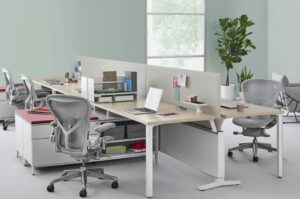
What are the Features that Make an Office Chair Ergonomic?
1. Adjustable Headrest
Although it isn’t a compulsory requirement, it needs to be modifiable if your chair contains a headrest. It will prevent you from having a stiff neck as you work. Besides, it best suits individuals who prefer working in a leaned position or those suffering from neck pains.
2. Lumbar Support
The chair should also provide sufficient lower back support. The lumbar spine curves inwards, and when you sit for an extended period without enough reinforcement, it reclines, which exerts pressure on your lower spine region. An ergonomic seat’s lumbar support allows you to alter the height and width to adapt to your sitting posture and weight.

3. Adjustable Arm Support
At a minimum, the seat should have a height-adjustable armrest. Robust arm support offsets the weight from your neck and shoulders, letting you rest them comfortably. Others are also width adjustable, meaning that you can move them far or closer to your body and efficiently support the elbows and arms irrespective of how you spread them. The adjustments favor people with narrower or broader shoulders.
Additionally, an ergonomic chair’s armrest offers pivot so you can place arm pads to angle the arm inward or outwards for better support while typing. This feature gives you a relaxed experience and cuts back the time needed to stretch after intensive writing.
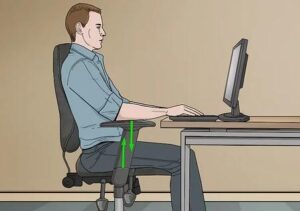
4. Adjustable Seat Depth
The chair should also allow depth modification to support users’ comfort. The correct depth leaves around one to four-inch space between the seat’s edge and knee back, irrespective of the body size or posture. It allows for sufficient blood flow and leg support. Note that a very shallow depth may exert excess pressure on your knees, and a profound one cuts circulation to your legs.
5. Chair Height Adjustment
An ergonomic chair should also have a feature that makes it lengthier or shorter to suit various body dimensions. The right size should allow you to sit with both feet on the floor and the knees bent at a right angle. Your thighs should also remain horizontal, and your knees leveled or a little lower than the hips.
On the other hand, the arm should be parallel to the spine; the elbow bent at 90 degrees as you rest the forearm and hand on the desk. If not, adjust the height higher or lower as required. It’s worth noting that prolonged use of a low-level seat may stress hips, ankle joints, and knees.
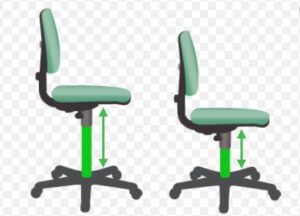
6. Backrest Adjustment
The capacity to modify your chair’s back height to position the contours in the rear cushion efficiently for maximum support makes a chair ergonomic. If it has a separate backrest, it should allow modification in both angle and height. Move it to a point where you feel your back is more supported to maintain the spine’s natural curve.
If the office chair has an inbuilt backrest, then it should allow backward and forward angles. Also, check out for a locking feature to secure it in place after setting the preferred angle to prevent unnecessary back movement.
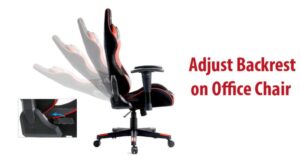
7. Seat Material
The seating area in your chair will bear most of your weight, and you need to ensure that it’s efficiently supportive without being overly firm. It should have enough padding, soft enough, but not saggy to support longer working hours. Concerning the shape, choose one with waterfall edges that relieves pressure on the thigh area and promotes blood circulation to your limbs.
In terms of the ergonomic chair material, you have various choices based on your preferences. Mesh appears quite breathable, flexible, easy to clean, and is ideal for people residing in hotter regions. On the other hand, leather seems softer, hypoallergenic, more comfortable to clean, and highly durable when appropriately maintained. Still, you can choose different fabrics in between leather and mesh.
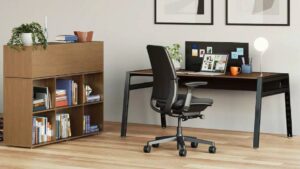
8. Quality Casters
Though often overlooked, an ergonomic seat should have some quality casters which allow you to move freely around your workspace. You require their support while entering or exiting the chair. Nonetheless, you need to select the right casters based on your office’s floor type to avoid damage.
In this case, hard wheeled works best on carpeted surfaces while soft ones seem hardwood friendly. The premium rubber casters will work efficiently on most floor types. However, beware that some cheaper models will break down quickly. You might also want to consider casters with some lockable features that prevent unnecessary rolling over or accidents.

9. Adjustable Tilt And Reclining Feature
The ergonomic chairs also come with backrest angle adjustments to help you open up your hips to relieve tension on the back while sitting. You can change this using the tilting or reclining feature.
A standard ergonomic chair should support tilting though some provide both functionalities. In case you need to lean back, the tilt and swivel mechanism changes the backrest angle keeping the lower body and gazes horizontal. This position creates some gentle movements in your body throughout the day to absorb pressure build-up due to a fixed backrest.
If you wish to adopt a horizontal posture to take a quick nap, read, or if you suffer from back pains, the reclining feature comes in handy. Reclining happens at the backrest independent of the seat, and you can therefore achieve a greater angle. Both tilting and reclining mechanisms allow you to occasionally switch positions, which improves blood circulation to boost alertness and reduce numbness.
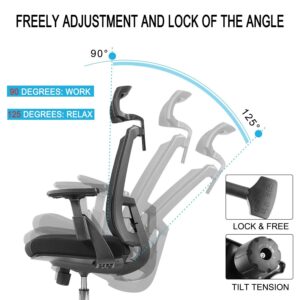
Conclusion
Most chairs look great but are not necessarily ergonomic. If you value comfort, it pays to look out for a chair that you can adjust to suit your working style and body. These types of seats will enhance your posture, reduce pains, joint pressure, and boost blood circulation, which translates to better productivity. The above guide outlines what makes an office chair ergonomic or not, to help you make an informed purchase.
